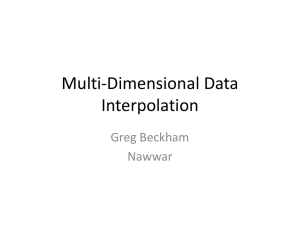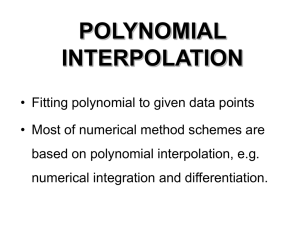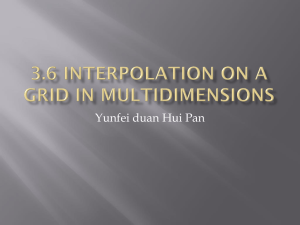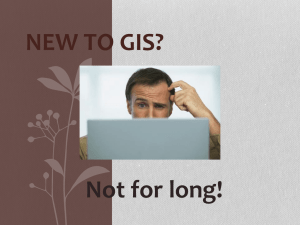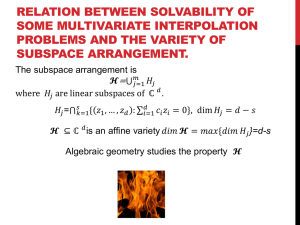Bulk Interpolation using R Environment
advertisement
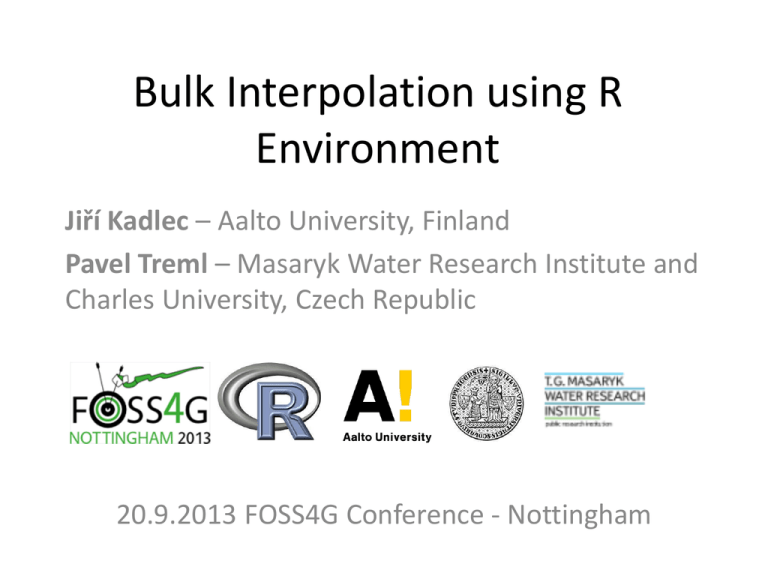
Bulk Interpolation using R
Environment
Jiří Kadlec – Aalto University, Finland
Pavel Treml – Masaryk Water Research Institute and
Charles University, Czech Republic
20.9.2013 FOSS4G Conference - Nottingham
Fields with Observations in time and space
What, Where, When (irregular sampling)
Time, T
“When”
t
A data value
2013-09-20
c
D
4.2
s
“What”
Praha
Vi
“Where”
Space, S
Air Temperature (C)
Variables, V
Image created by CUAHSI, 2010
Type of data in this tutorial
station
Observations longitude
latitude
variable
time
value
Praha
14.430
50.0156
temperature
2013-03-31
-0.2
Praha
14.430
50.0156
temperature
2013-04-01
1.1
Praha
14.430
50.0156
snow
2013-04-01
3.0
Brno
16.254
49.147
temperature
2013-03-31
-0.1
Brno
16.254
49.147
snow
2013-03-01
12.0
• Tens of variables
• Hundreds of stations
• Hundreds of
observations per station
• Incomplete data
TASK
For each time-step,
Examine how one or
More variables change
In space
Interpolation
• Deterministic methods
• Geostatistical methods
• Repeated over many time steps
• How to automate?
Interpolation - Space
Interpolation - Time
value
lat
?
?
time
lon
the R Environment
Free statistical software
Windows, Mac, Linux
Create High-quality graphics
Many input data formats
– Text file
– Vector data (shapefile)
– Raster data (grid)
Many output data formats
– Picture
– Text file
– Raster, vector
Scripting language
for automating
repeated tasks
Case study: Maps of air
temperature and
snow, Czech Republic
• Year 2013 (365 maps)
• Require identical color-scale
START
Load Data
sets
Select next
time
Select
matching
observations
• Need to show rivers, boundaries
• Need to show point values (to
assess interpolation)
YES
Run
Interpolation
Create map
cartography
More
times
?
NO
END
Load Data Sets – Raster (SRTM elevation)
Library(“sp”)
library(“raster")
library(“rcolorBrewer")
srtm <- raster("srtm_utm.asc")
colors=brewer.pal(6, "YlOrRd")
intervals = c(0, 250, 500, 750, 1000, 1600)
spplot(srtm_proj, col.regions=colors, at=intervals)
Visualize raster using
spplot
Note:
You can get DEM for your area in R using:
Select packages
With needed functions
Raster:
Load from local file
Color ramp setting
Load Data Sets – Vector (boundaries, rivers)
library(“maptools")
library(“sp")
Select packages
With needed functions
border = readShapeLines(“border.shp")
border_layer = list("sp.lines", border, lwd=2.0,col=“black")
rivers = readShapeLines(“rivers.shp")
proj4string(rivers) <- CRS("+proj=krovak +lat_0=49.5
+lon_0=24.83333333333333")
rivers_proj <- spTransform(rivers, CRS("+proj=utm +zone=33"))
river_layer = list("sp.lines", rivers_proj, lwd=1,col=“blue")
layout = list(river_layer, border_layer)
spplot(srtm, sp.layout=layout)
Visualize vector datasets
on top of raster
Borders:
Load shapefile
Rivers:
Load shapefile,
Reproject vector from
Krovak to UTM system
Load Text File – Point Data (Stations)
At first, we can use a subset (for first date/time in the dataset)
data = read.table(“data.txt”,
header = TRUE, sep = "\t", dec = ".")
st = subset(data,
DateTimeUTC == ‘2012-08-12’ &
VariableCode==“SNOW")
Coordinates(st) = ~Long + Lat
proj4string(st) = CRS("+init=epsg:4326")
stations <- spTransform(st,
CRS("+proj=utm +zone=33"))
stations_layer = list("sp.points", stations, pch=19,
cex=1.0, col="black")
labels = list("panel.text",
coordinates(stations)[,1], coordinates(stations)[,2],
labels=stations$value, col="black", font=1, pos=2)
layout = list(stations_layer, labels)
Reproject from Lat/Lon to UTM system
All Layers together (raster, vector, points)
(We use different color ramp in this example)
Interpolation: IDW and Kriging Methods
Interpolation: Covariate (Elevation)
model = lm(value ~ elev,
data)
intercept =
model$coefficients[1]
slope =
model$coefficients[2]
plot(value~elev, data)
abline(model)
In our case temperature is often negatively
correlated with elevation
TEMP = a * ELEVATION + b
Interpolation: Elevation as covariate
Using TEMP = a * ELEVATION + b
Instead of interpolating temperature directly,
we create grid using regression equation and
we only interpolate the residuals
residuals
Interpolated residuals
TEMP = a * ELEVATION + b
Combination (regression + interpol.
residuals
Color Breaks, Color Ramps
One color ramp and set of user-defined color breaks easily re-used for different grids
#user-defined color breaks
colors = rev(brewer.pal(8, "YlGnBu"))
brk <- c(-40,-35,-30,-25,-20,-15,-10,-5,0)
plot(grid,breaks=brk,col=palette(colors)
RColorBrewer packages provides
Pre-defined color ramps
Example Final Map: One time step
Combines the previous steps …
Snow depth (cm): 2013-01-01
Saving map to file
• Set image size
• Set image resolution
• Other options (margins, multiple maps in one image)
figure = “2012-02-07.jpg”
png(filename = figure, width = 1500, height = 1000, pointsize = 25, quality =
100, bg = "white", res = 150)
DO THE PLOT COMMANDS HERE
dev.off()
PNG picture
JPEG picture
PDF file
WMF file
.asc ascii grid file (for GIS softwares)
……..
Bulk Interpolation: “FOR” loop
(multiple time steps)
START
Schema of the Loop
Load Data
sets
for (j in 1:length(timesteps)) {
# select subset of observations
# run interpolation
# create map
# export map to file (picture, pdf, …)
}
Select next
time
Select
matching
observations
YES
Run
Interpolation
Create map
cartography
More
times
?
NO
END
Final Map: Multiple time steps
R as Compared with Desktop GIS
Desktop GIS
R Statistical Software Environment
Maps are highly interactive
(-) Maps are static
Create small number of maps with
graphical user interface
(-) Some commands counter-intuitive for
novice user
Automated cartography
(label placement…)
(+) Create very large number of maps
with same cartographic symbology
Map-Layout, model builder tools
(+) Task is easy to automate and reproducible
ArcGIS, QGIS, SAGA, MapWindow,…
IDV, Panoply, …
(+) Good documentation and large user base
Desktop GIS: project file (.mxd, .qpj, …)
R: script (.R)
References
BOOKS
• Bivand, Roger S., Edzer J. Pebesma, and Virgilio Gómez Rubio. Applied
spatial data: analysis with R. Springer, 2008.
• Hengl, Tomislav. A practical guide to geostatistical mapping of
environmental variables. Vol. 140. No. 4. 2007.
WEBSITES
• www.spatial-analyst.net
• www.r-project.org
• http://hydrodata.info/api/ (source of data in our demos)
R-PACKAGES USED
RColorBrewer, maptools, rgdal, sp, raster
Try the scripts yourself!
hydrodata.info/R/
• Sample scripts for bulk interpolation
• This presentation
• Source data { central Europe meteorological
observations }
